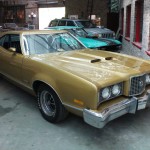1973 Mercury Montego
This 1973 Montego is getting mechanical work done. We’re replacing the blower motor, fixing a differential leak, and replacing the manifolds with headers. TrimWorks will get in on the action with rebuilding the seat foam.
Explore the Project Galleries
Vehicle
Mechanical
The Montego nameplate appeared in 1968, in an appalling alliterative attempt to get most of Mercury’s machinery to match monikers (Monterey, Marquis, Marauder, etc). Like its stacked-headlamp Comet predecessor, the first Montego featured a unit-body chassis; also like its predecessor, it spawned a “supercar” version called Cyclone. (Apparently Mercury was also sponsored by the letter C-more alliterative names like Cougar, Comet, Cyclone, Capri and Commuter commanded the carmaker’s call-sign concurrently.) The usual multitude of bodystyles-two-door formal roof, two-door fastback roof, convertible, four-door sedan and wagon-were available. The 1970 redesign took the basic look of the earlier vehicle and exaggerated it dramatically (particularly around the nose, which looked like the letter M when viewed from the top), offered a single semi-fastback roofline, axed the convertible completely, and watched as intermediate sales dropped off 52 percent by 1971. Small-car sales took up the volume left off by the mid-size models … but at lower profits. Ford’s newly redesigned big cars, meanwhile, sold 125 percent of what they did the year before.
The way to higher profitability was clear. With the muscle car era coming to an end, Montego (and its Ford Torino sibling) got the single most extensive overhaul of the nameplates’ existence in 1972. Wheelbase for the two-doors actually shrunk three inches, to 114 inches (though it expanded to 118 on sedans and wagons), but for the first time Ford’s mid-size line sported a proper perimeter frame, not unit-body construction. The rear suspension became a coil-spring four-trailing-arm system, replacing the leaf-sprung rear of its predecessor, and track widened two full inches front and rear. The styling was evolutionary: the excesses of the 1970-71 models were trimmed back, and while the nose was still countoured, with a protruding center section and an eggcrate theme that carried on from the previous season, it wasn’t nearly as exaggerated. Two roof styles were available on the coupe-a true fastback and a more formal roofline-and taillamps moved into the bumpers. This, plus a new emphasis on comfort and luxury, all contributed to making the new car weigh a whopping 400 lbs. more than the unibody ’71 it replaced. Despite what the shipping weights say, that’s awfully close to two tons at the curb-for a mid-size.
Clearly, performance was on the way out, further evidenced by the once-mighty Cyclone being downgraded to an option package, rather than a model in its own right; Montego GT was the new name of mid-size performance at Mercury. By 1973, Cyclone was a memory, and the most sporting models could be seen driving around in circles on Sundays, with David Pearson behind the wheel.
At the same time, power ratings dropped (at least on paper, thanks to the new “net” power rating system replacing the optimistic old “gross” scheme); the base one-barrel 250-cu.in. straight-six was rated at an appalling 98hp; the two-barrel Windsor 302-cu.in. V-8, which was standard on the Montego GT, eeked out 140hp; the optional two-barrel 351C was rated at 163hp; and the two four-barrel Cleveland options, with and without the cold-air Cobra Jet package, were rated at a respectable 266hp and 262hp, respectively. The 172hp, two-barrel 400-cu.in. V-8 seemed pointless (more cubes for less money?), and the once-mighty N-code 429 had been trimmed back to an embarrassing 205 rated horsepower-50hp less than the smaller 351 Cleveland four-barrels.
The midsize Mercury’s new orientation toward pure luxury worked. Montego sales not only shot up 125 percent over the previous season’s dismal numbers, but it also took up a far greater piece of the division’s sales pie, from about 15 percent in 1972, to more than 30 percent in 1972. Not only were muscle cars dying, but sales of the luxury versions only served to drive a stake through the genre’s big-block heart.
Popular Montego options included: air conditioning ($397.91), power steering and power windows ($112.33 each), power front disc brakes ($68.14), AM/FM stereo radio ($213.29; an AM-only unit was $58.94), power locks ($44.17 in two-doors, $66.89 in four-doors), a six-way power bench seat ($102.22), whitewall tires ($34), dual racing mirrors ($12.62), left-hand remote mirror ($12.62), instrumentation group ($99.71), and interval windshield wipers, deluxe wheel covers, or the visibility group (each priced at $25.24). (Only 1972 prices are listed.)
The 1972 models had a one-year-only nose, as the 1973 models suffered the government’s new bumper legislation-making each model full of one-year-only sheetmetal ahead of the front wheels. Montego was redesigned again in 1974, when all sporting pretense (including the GT package) was removed once and for all; the Montego nameplate died in 1976, replaced by a now-unrecognizable Cougar lineup. The 114/118-inch-wheelbase frame, however, lasted clear through to 1979, underpinning Cougar, corporate sibling Ford Thunderbird, and a variety of Ford nameplates including Gran Torino, LTD II and Elite. The Montego nameplate is returning in 2005, again on an intermediate Mercury lacking any sporting pretension.
Read more about Mercury Montegos at: http://www.hemmings.com/hmn/stories/2004/11/01/hmn_feature2.html





